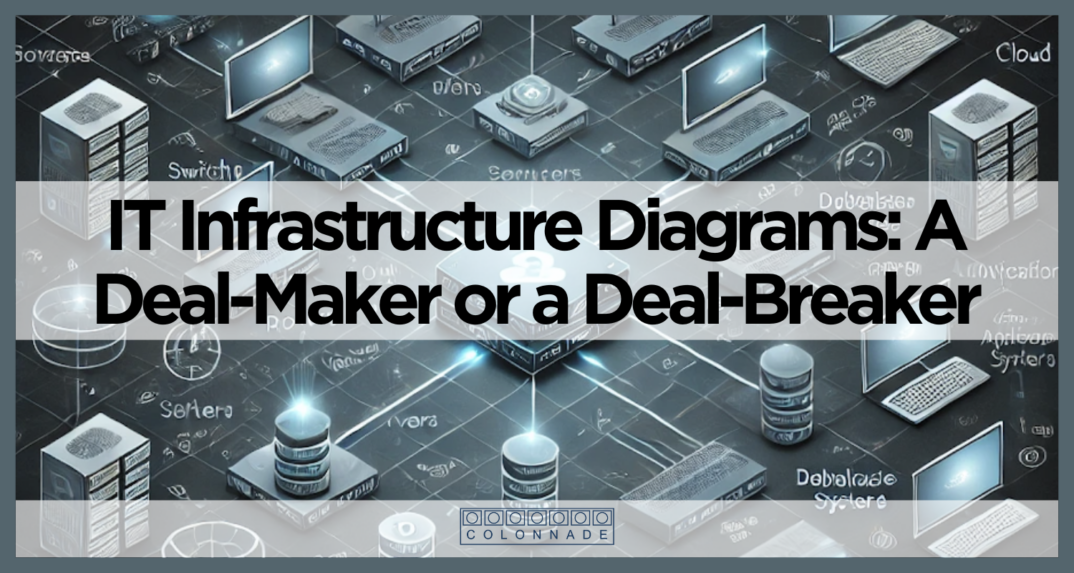What Goes Into an IT Infrastructure Diagram—and Why It Matters in M&A

In today’s deal environment, understanding a target company’s technology backbone is no longer optional—it’s mission critical. As digital operations expand, an IT infrastructure diagram has become a foundational tool in technical due diligence. It’s not just a visual map—it’s a risk indicator, a cost driver, and a strategic asset.
So, what exactly goes into a robust IT infrastructure diagram? At Colonnade Advisors, we work with CIOs, CTOs, and technology diligence partners to break down the key components. Here’s what to look for—and why it matters.
1. Core Network Components: The Plumbing Behind Digital Operations
A well-designed IT infrastructure diagram begins with the backbone of connectivity:
- Routers: Direct traffic between internal networks and the internet, or between offices and data centers.
- Switches: Connect internal devices and ensure efficient data flow within a location.
- Firewalls: Define security boundaries, showing where network access is allowed or restricted.
- Load Balancers: Distribute workloads across servers to ensure availability and performance.
- VPN & Remote Access Gateways: Provide secure pathways for employees and third-party vendors to access internal systems remotely.
Why it matters in M&A: These components reveal system scalability, resiliency, and exposure to cyber risk. Buyers want to know: Is the network modern, redundant, and secure—or patched together with legacy tech?
2. Data Centers & Cloud Infrastructure: Where the Business Lives
Whether on-premises or in the cloud, understanding compute and storage architecture is vital:
- On-Prem Servers & Storage: Physical assets including NAS/SAN devices and backup systems.
- Cloud Platforms (AWS, Azure, GCP): Workloads, databases, APIs, and service tiers deployed in the cloud.
- Virtualization (VMs, Containers): Kubernetes, Docker, and other virtualization tools running dynamic workloads.
- Disaster Recovery & Backup Sites: Offsite or secondary environments for business continuity.
Why it matters in M&A: Cloud-native companies often carry lower CapEx but may have higher OpEx. Diagrams showing hybrid models or outdated on-prem setups suggest future integration costs.
3. Security & Compliance Layers: The Defense Perimeter
A strong security posture is not optional—it’s a prerequisite for enterprise value:
- Identity & Access Management (IAM): Systems like Active Directory, Okta, and Duo that control user access.
- Multi-Factor Authentication (MFA): Adds layers of user verification.
- Network Segmentation & VLANs: Isolates sensitive data for security and compliance.
- Security Information & Event Management (SIEM): Centralized logging and alerting via Splunk, QRadar, etc.
- Endpoint Detection & Response (EDR): Antivirus, threat monitoring, and remediation tools.
Why it matters in M&A: An M&A target with weak or inconsistent security may require costly remediation—or represent regulatory risk post-close.
4. External Connectivity: Ties to the Outside World
The diagram should detail all inbound and outbound digital pathways:
- ISPs: Including primary and backup internet connections.
- DNS & Proxy Servers: Traffic routing and web filtering infrastructure.
- Email & Messaging: Microsoft 365, Google Workspace, or proprietary systems.
- CDN & Web Application Firewalls (WAFs): Global traffic optimization and web security.
Why it matters in M&A: This section exposes weak points that might lead to downtime or data leaks. It also reveals whether redundancy and uptime SLAs are in place.
5. User & Endpoint Devices: What People Touch
No IT infrastructure is complete without mapping the endpoints:
- Workstations & Laptops: Device mix, BYOD policies, and management tools.
- Printers, Scanners, IoT Devices: Often overlooked but may introduce risk vectors.
- Mobile Device Management (MDM): Controls for smartphones and tablets.
Why it matters in M&A: Unmanaged devices increase vulnerability. Visibility into endpoints informs integration planning and security posture.
6. Applications & Databases: The Digital Nerve Center
This is where IT becomes business-critical:
- Enterprise Applications: ERP, CRM, and HR platforms such as Salesforce, SAP, and NetSuite.
- Web Hosting: Internal vs. public-facing services, including domain ownership and certificate management.
- Databases: Relational (SQL Server, PostgreSQL) and non-relational (MongoDB) systems.
- Analytics & Data Warehouses: Tools like Snowflake, BigQuery, or Redshift used for business intelligence.
Why it matters in M&A: The diagram should highlight performance dependencies and licensing costs. Buyers also evaluate how well these systems scale or integrate with their own stack.
7. Backup & Recovery: What Happens When Things Go Wrong
The diagram must include resiliency infrastructure:
- Automated Backups: Frequency, format, and storage locations.
- Power Redundancy: Uninterruptible Power Supplies (UPS) and alternate ISPs.
- Disaster Recovery Data Centers: Whether the backup strategy is Hot, Warm, or Cold.
Why it matters in M&A: Downtime kills value. Buyers want assurance that there’s a viable plan for worst-case scenarios.
8. Network Traffic Flows & System Dependencies
Finally, infrastructure diagrams must trace how data moves:
- Internal Data Flows: Movement between applications, databases, and services.
- External Flows: Integrations with SaaS platforms, APIs, and third-party vendors.
- Critical Dependencies: Which systems must remain live to avoid business disruption.
Why it matters in M&A: This layer uncovers hidden interdependencies and integration risks. It’s essential for post-close planning and Day One readiness.
Final Thoughts
A complete IT infrastructure diagram isn’t just a checkbox in due diligence—it’s a blueprint of how a business runs. At Colonnade Advisors, we see firsthand how well-documented infrastructure directly influences deal timelines, valuations, and integration success.
For companies preparing to go to market, investing in a clear, current, and comprehensive diagram can help streamline diligence and demonstrate operational maturity. For buyers, it’s a litmus test of readiness—and resilience.
If you’re considering a transaction and want to know whether your infrastructure tells the right story, let’s talk.


